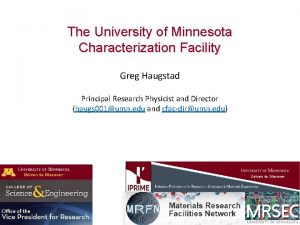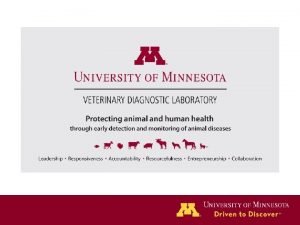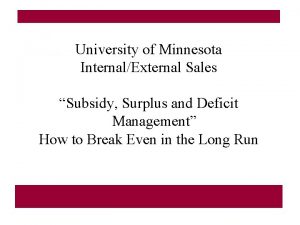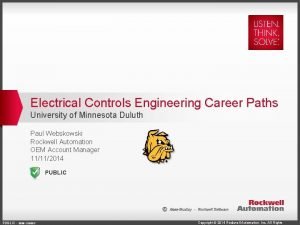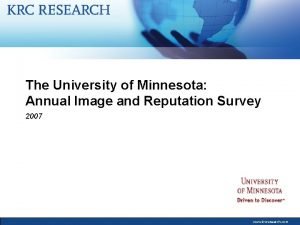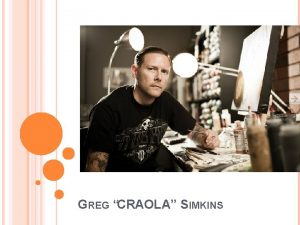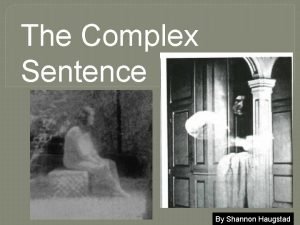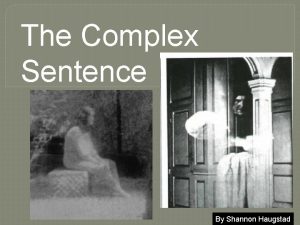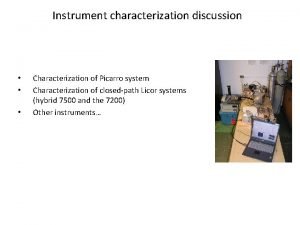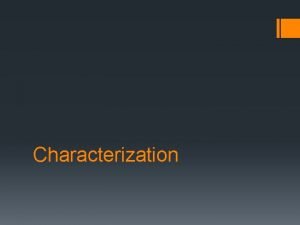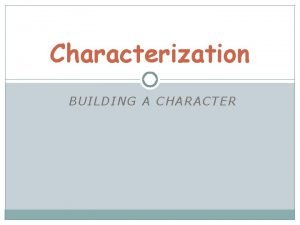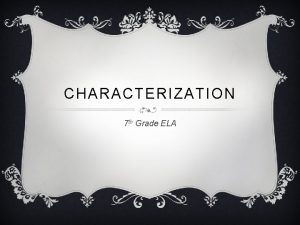The University of Minnesota Characterization Facility Greg Haugstad









- Slides: 9

The University of Minnesota Characterization Facility Greg Haugstad Principal Research Physicist and Director (haugs 001@umn. edu and cfac-dir@umn. edu)

Characterization Facility (Char. Fac) Locations University of Minnesota – Mpls campus LRT Ra mp T 1 Ramp LRT 3 Hotel LR M I S S I S 2 S Ramp I P P I RIVER

Dunn Brothers University of Minnesota Earth Sciences East Bank Campus; 3 Char. Fac Locations Northrup Auditorium M I S S I P P I 1. Sci. & Eng. Library Wise Owl Cafe Chemistry 1 R I V E R Chemistry 2 Civil, Env. & Geo. Eng. Shepherd Labs M A L L Physics 1 Inst. Math &Appl. Mech. Eng. Starbucks Aerosp. Eng. Electr. Eng. Chem. Eng. & Mat. Sci. Starbucks Weisman Museum Biomed. Eng. Coffman Union; Einstein Brothers 2. Nils Hasselmo Hall Genetics Cell Biol. Devel. * Biochem. Molec. Biol. Biophys. Physics 2 / Nano Washington Ave. Parking Ramp LRT station Pharma. Caribou Coffee Inst. Molec. Virology 3. Moos Tower Freshii Rec. /Health Club Commons Hotel **** Starbucks

University of Minnesota Characterization Facility • >$20 million of equipment (replacement value) v v v Electron microscopes: 6 TEM, 5 SEM/FIB, cryogenic/analytical X-ray scattering: 7 wide-, 1 small-angle, 2 micro, variable Temp Proximal nanoprobes: 4 AFM, STM, profilom. , 4 indentors Surface analytical: XPS/UPS/Auger, sputter, microtensiom. Chemical spectro/microscopy: confocal Raman, FTIR/ATR Thin film analysis: RBS w/PIXE/FRe. S, spectrosc. ellipsom. Newest systems • ~11 FTE scientific staff (permanent) • ~600 research users/yr, ~100 external • ~135 faculty users from ~35 UMN departments/units • ~250 students/yr in curricular classes & short courses • ~50 companies per year • ~20 external academic v Hard & soft materials, liquids, institutions per year www. charfac. umn. edu bio/medical, enviro/geo/anthro v Expert analytical services, custom methodologies v External collaborations v Workshops & short courses Other pertinent facilities on campus: State-of-the-art light microscopy (superresolution, etc. ) University Imaging Center Rheology/DSC/TGA, NMR, Mass spectrom. , X-ray tomography/electron microprobe Micro-/Nano-fabrication, Bioprocessing (fermentation, etc. ) XPS, UPS, cluster beam Dual-beam FIB/SEM Small-angle X-ray scattering Clientele: “Like a national lab”

Motivations in Char. Fac’s industry collaborations • Increase understanding of, proficiency with, analytical methods, (whether new modalities or ones we have not used much, or correlative methods, i. e. , multiple techniques). • Develop new analytical methodologies, expand utility. (thereby attract users / clients / collaborators) • Obtain interesting / challenging samples. (We are analytical scientists not synthesists or engineers. ) • Provide a technological context for methods research (synergistic with proprietary work we do).

Char. Fac Technical Staff 13 professionals (11. 3 FTE) manage 3 -site capabilities. Includes expert analytical services, education/training, assistance/consultation, methods development, collaboration. Electron microscopy X-ray scattering Proximal probes Vibrational spectroscopy Surface Analytical Thin film analysis Chris Frethem SEM (cryo and bio/soft material emphasis) Dr. Javier Garcia-Barriocanal XRD, Small-angle X-Ray scattering, IBA Dr. Bob Hafner High-contrast and cryo TEM (bio, soft materials emphasis) Dr. Greg Haugstad AFM, Ion beam analysis (IBA: RBS, PIXE, FRe. S & related) Dr. Jong Jeong (0. 15 FTE) Titan TEM Dr. Han Seung Lee SEM/TEM (cryo emphasis), Small-angle X-Ray scattering Dr. Bing Luo Confocal Raman/FTIR, XPS, micro-contact angle, Auger Dr. Jason Myers FEG-TEM (HR/STEM/EDS/EELS), FIB Dr. John Nelson (0. 1 FTE) Nano/micro-mechanical, stylus profilometry Dr. Geoff Rojas Auger, UPS/XPS, STM/AFM, TEM Dr. Nick Seaton SEM (hard materials emphasis), FIB, EDS/EBSD/cathodolum. Dr. Seema Thakral (0. 6 FTE) XRD, Small-angle X-Ray scattering Dr. Wei Zhang (0. 45 FTE) Cryo FEG-TEM, 3 D reconstruction, tomography Fang Zhou, MS Bio EM specimen prep, (cryo)microtomy, TEM (bio, soft material) Contact Information at www. charfac. umn. edu/staff

Modern needs for broadly talented and highly engaged staffing (i. e. , beyond default management of equipment and provision of basic training) 1. Broadly talented: Expertise in i. correlative methods including imaging, spectroscopy, and/or others (e. g. , mechanical) that co-register datasets combining disparate information; ii. hyperspectral imaging – spectral data interlaced with imaging within a single instrument); iii. data management and informatics to handle orders-of-magnitude larger datasets (“big data”); iv. advanced data analytics (e. g. , principal component analysis) and extending in some cases to the supercomputer regime (e. g, 3 D reconstruction from TEM); v. computer programming to expand capabilities whether on the measurement side (e. g. , Lab. View, python scripting, …) or data processing/analyzing side (e. g. matlab, origin, visual basic, …). 2. Highly engaged: Staff scientists who are proficient (and sought) as consultants, mentors, and collaborators, to propel the usage of increasingly advanced analytical tools to higher levels. Get past early-1990's paradigm of having grad students receive only novice levels of training and correspondingly use techniques at “austere” levels of creativity and understanding. (Justify state-of-the-art, multimodal instruments in core facilities, not just in single. PI labs that groom analytical experts as explicit components of their theses. )

What to encourage and enable with expert staff Nurture academia-based scientists as 1. Stewards of capabilities as presumed; actual time on instrumentation to i. ensure fully functional and optimized performance; ii. continually upgrade capabilities; iii. prevent (or mitigate) abuse; iv. catalyze advanced usage by more than just the staff. 2. Actual practitioners – greater emphasis on developing expertise than on grant writing, supervising, meetings, administrative tasks 3. Actual mentors and educators i. sufficient facetime with trainees, in the context of their research; ii. contributions to the formal curriculum/practicum, such that it utilizes core-staff expertise and does not shortchange analytical education 4. Actual scholars i. opportunities to flourish as writers, whether in primary journal articles, reviews, book chapters, monographs (or all of the above) ii. ample time to serve in peer review – improve the state of measurement science as reported in the literature

Professional credit, development, visibility 1. Co-authorship i. Lead scientist/intellect behind a portion of the analytical research in a given publication; most “answerable” to the technical community. ii. Provide proper presentation of measurement science to ensure validity and reproducibility. iii. Ensure that the name responsible for generating and analyzing data is contained in future citations (i. e. , not in the acknowledgments). 2. Independent scholarship i. Communicate the unique perspective of a hands-on experimentalist. ii. Develop and publish special analytical methods. iii. Generate methods chapters or monographs to be used in education. 3. Conference, workshop and short course presentations i. Assign a face to who has done the work, where the intellect resides. ii. Provide a venue for practitioners to exchange know-how and advance their collective domain of analytical science. iii. Foster interactions that lead to new collaborations, trainees or contract work, to improve a facility’s bottom line.
